Content
Indoor saxifrage is actually a synonym for the name of only one species out of 440 representatives of the family. All these herbs grow on rocky soil, and often in rock crevices. For this they got their name. A significant number of species are used in horticulture. But usually all these plants are used in landscape design, where they look the most advantageous. And as a home flower, only braided saxifrage is grown.
Types of saxifrage for growing at home
Of almost half a thousand species of saxifrage, only three are the most popular:
- wicker;
- pyramidal, or cotyledon;
- Arends hybrids.
The popularity of the wicker saxifrage as a houseplant is due to its unpretentious care and ease of reproduction. But she is quite able to withstand frosts down to -25 ° C. If you wish, you can place it in the garden. Like other types of saxifrage.
Wicker saxifrage
The Latin name is Saxifraga stolonifera. But this perennial flowering herb has other names, sometimes funny:
- strawberry saxifrage;
- Aaron's beard;
- mother of thousands (refers to many unrelated plant species);
- a wandering sailor;
- a wandering Jew;
- strawberry begonia;
- strawberry geranium.
At the same time, the braided saxifrage has nothing to do with begonias or geraniums. And the name "mother of thousands", obviously, is given for the ability to produce many stolon-like "antennae" shoots.
The original habitat of this species covers China, Japan and Korea. Under natural conditions, the flower grows in relatively humid areas:
- the woods;
- meadows;
- thickets of bushes.
It is also found on rocks. The height of the grass habitat is 400-4500 m above sea level.
As an ornamental plant, indoor saxifrage was introduced to the temperate regions of Eurasia and North America, where it took root well in the wild. It is grown as a home flower all over the world.
The height of the grass is 10-20 cm. The rosette leaves are rounded with small but wide denticles at the edges. Like the reddish petiole, covered with bristles. The color can vary greatly. There are photos of wicker saxifrage with leaves:
- plain, dark green;
- dark green with light streaks, the most common option;
- light green with red patches and light streaks.
The underside of the leaves is reddish.
Loose paniculate inflorescence consists of 7-60 five-petal small flowers. Their appearance is very characteristic: 2 lower petals are much longer than 3 upper ones. Flowering time is May-August.
This species reproduces mainly with the help of "antennae" stolons. That is, the grass actually clones itself. The stolons are up to 21 cm long. New clones take root near the mother plant. Due to this, saxifrage is often used in landscape design as a ground cover plant.

Flowers that are very delicate and pleasant individually seem inconspicuous when collected in inflorescences
Saxifrage Cotyledon
Cotyledon is a tracing paper from the Latin name Saxifraga cotyledon. In Russian, this species is better called pyramidal saxifrage. Origin - mountains in Europe, but not the Alps. More precisely, only part of them is included in the range of this plant. It prefers a cold climate, so it grows in the "arctic" regions:
- Norway;
- The Pyrenees;
- Iceland;
- Western Alps.
Although the Pyrenees Mountains are usually associated with a hot climate, it all depends on the altitude.
Externally, in the photo, the rosette leaves of the pyramidal saxifrage and succulents from the Tolstyankov family are very similar. No wonder. Both families belong to the Kamnelomkov order. But the Cotyledon saxifrage is not a succulent.
The height of the rosette leaves is about 20 cm. The flowering stem reaches 60 cm. It blooms in May-June. The panicles of white flowers are shaped like pyramids or, rather, cones.
This type is often used to decorate alpine slides and rockeries. But as an indoor flower, pyramidal saxifrage does not even appear in the photo. This is due to its needs in very poor soil, the height of the peduncle and the not very attractive appearance in the pot. Succulents look more interesting at home. And the pyramidal saxifrage looks more advantageous on the "rock" in the garden.
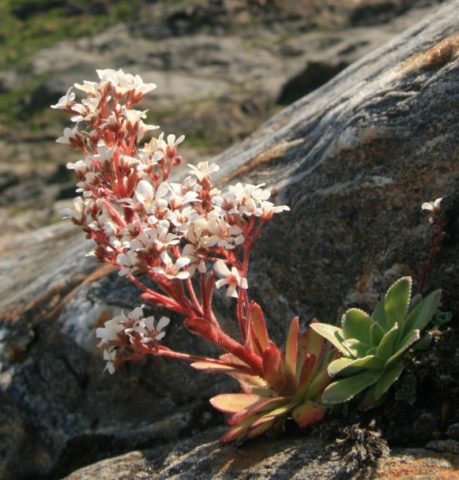
Cotyledon is one of Norway's two national colors
Arends' saxifrage
This is a group of complex hybrids of the genus Saxifrage. The cultivation is associated with the German breeder Georg Adalbert Arends. The varieties differ in the shape of the leaves and the color of the petals.
General characteristics of hybrids:
- perennial;
- herbaceous;
- evergreen;
- leaves are collected in dense small rosettes.
But the shape of the leaves can vary. Although they are usually lobed and more or less dissected. Petioles are wide and flat. The surface is glossy.
Duration of flowering of one plant is about a month. In Central Russia, Arends saxifrage bloom in April-June.
Hybrids are popular as garden plants. Landscape designers willingly arrange alpine slides with them. But as a houseplant, Arends' saxifrage is rare.
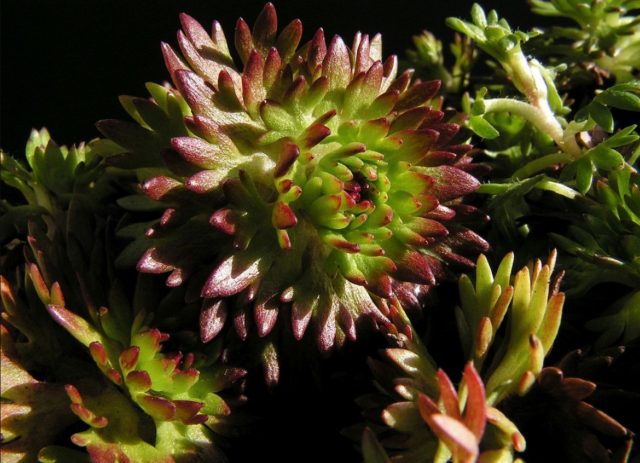
Rosettes of leaves tightly pressed together resemble moss thickets, hence the English name "mossy saxifrage"
Breeding features
In most cases, saxifrage is propagated by seed. The retention of germination for three years and a large percentage of germination make this method a good way to acquire a flower if there is no way to get seedlings.
In indoor conditions, saxifrage is propagated not only by seeds, but also by dividing the bushes. Each year, the plant produces new shoots. After the mother specimen has faded, the young are carefully separated and rooted in a shaded place.
But the "mother of thousands" has a more profitable method. She grows long, thin shoots on which her offspring clones appear. If the indoor saxifrage grows in the garden, and the "cubs" have the opportunity to take root, the plant acts as a ground cover. At home, it is an ampelous flower. And not leaves or stems hang down from the pot, but stolons with new clones that have no opportunity to root. Reproduction by rosettes is so successful that other methods are no longer used in relation to room saxifrage.
It is very easy to carry out the procedure with clones. It is enough to place the pot on a suitable surface and place it around the container for young plants. After that, each tendril is placed one at a time in a new pot and slightly sprinkled with earth. The bottom of the socket should be pressed firmly against the damp ground. After a few days, the clones take root and the stolon is pruned.
Often, roots are formed on the rosettes of the room saxifrage hanging in the air. In this case, you do not even need to wait for rooting to cut off the shoot.You can immediately gently plant a new plant in another pot.
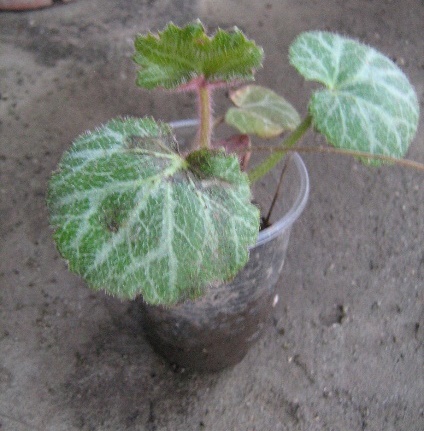
Usually, during reproduction, the stolon is cut off immediately, since the clones root perfectly even without "insurance"
Care after purchase
The newly acquired indoor saxifrage is placed in partial shade. In stores, they do not always monitor the moisture content of the soil, so the dried substrate must be moistened. The transplant is carried out if necessary and not earlier than 7 days after purchase. At the same time, it is impossible to do popular and convenient transshipment. Before planting in a new container, the roots of the saxifrage are completely cleaned of the old soil.
The rules for planting and caring for saxifrage at home after the acclimatization period also have their own characteristics. For a plant to develop well, it needs to create conditions similar to natural ones.
Rules for caring for saxifrage at home
When grown in the garden, saxifrage does not require special care. These are very unpretentious plants that need only the absence of direct sunlight. Seedlings are planted in shallow holes, dug at a distance of 15-20 cm from each other. Saxifrage prefer slightly alkaline drained soil. To obtain the soil of the desired quality, add to it:
- gravel;
- sand;
- turf;
- slaked lime.
Caring for saxifrage wicker at home is simple, but indoor flowers have their own nuances. Since it is originally a wild plant, certain rules must be followed when growing saxifrage at home.
Microclimate
In indoor conditions, saxifrage grows well on windows on the north side. But, like most colors, west or east is preferred. They cannot be grown on the south side of the apartment.
During growth, the optimum temperature for saxifrage is 20-25 ° C. In winter, it is reduced to 12-15 ° C. But in an apartment it is often impossible to maintain the temperature regime, and in winter the room saxifrage is too warm. In this case, you need to provide the flower with additional illumination. Without it, the plant will have a lot of stolons.
In indoor conditions, it is better not to keep the saxifrage on the windowsill, providing it with a semi-shady place. The brighter the light, the paler the leaves of the flower. If the light is too strong, they will not show all their beauty.
But with a lack of light at the room saxifrage, stolons do not stretch. Accordingly, you can determine what the plant needs and create the most favorable living conditions for it.
The saxifrage has one peculiarity: the higher the air humidity, the more beautiful its leaves. In addition, the main pests of the flower - spider mites and worms - are very fond of dry air. You can increase the humidity by spraying the flower with a spray bottle. But do not achieve results by frequent watering. Saxifrags do not like waterlogging of the soil.
Watering schedule
Both in nature and in indoor conditions, saxifrage prefer dried soil. This does not mean that they should not be watered. But the summer irrigation schedule is made, focusing on the presence of moisture in the soil: the top layer must be dry. You need to be especially careful in winter. During this period, only light soil moisture is maintained, and the plants are watered as rarely as possible.
If moisture lingers in the root outlet, the saxifrage will rot due to the development of a fungal disease.

Any universal fertilizer is suitable for saxifrage, but it is better to choose one that is intended for indoor plants.
Top dressing
Since this herb belongs to evergreens, it needs feeding all year round. If you do not provide a room saxifrage with fertilizers, its stolons are strongly stretched and lose their decorative effect. In winter, liquid fertilizers are "issued" once a month. During the growing season and flowering, that is, from spring to autumn, once every two weeks.
It is better to underfeed the saxifrage when kept indoors. It is undesirable to use nitrogen fertilizing, as they will provoke the growth of leaves. For this flower, phosphorus-potassium fertilizers are more useful.
Transplant rules
When cultivated in the garden, saxifrage does not require replanting. But if it grows in a pot, it needs a more spacious container from time to time. You need to transplant the flower very carefully so as not to damage the stolons and leaves. Better to do it together. A second person is needed to support the drooping antennae with new rosettes.
When to transplant
The saxifrage can grow in one container until roots crawl through the drainage holes of the pot in mass quantities. When this sign appears, the room saxifrage is transplanted into a more spacious container.
The timing of the transplant for indoor maintenance does not matter, but it is better to do this after flowering and before a dormant period. Although, if necessary, this can be done even during the growing season.
Tank and soil preparation
The container should be shallow but wide. A thick layer of drainage material is placed on the bottom:
- pebbles;
- expanded clay;
- broken brick;
- rubble.
The flower is undemanding to the ground. The main thing for him is that the soil passes water well. As a substrate, you can use a regular houseplant mix that you can buy at the store.
But you can make the soil yourself. This will require:
- sheet land 40%;
- non-acidic peat 20%;
- coarse sand and finely crushed stones 20%;
- sod land 20%.
All components are mixed and filled in the pots so that there is still room for water. Plants are planted at the same time as the containers are filled with soil.
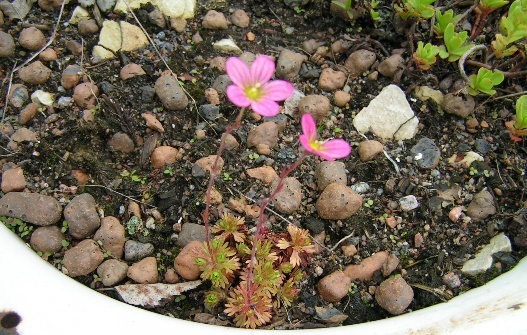
Stony soil that is highly permeable to water is optimal for indoor and garden saxifrage
Transplant algorithm
Indoor saxifrage is transplanted in the "old" way, getting rid of the old soil. It is best to carefully remove the flower along with the earthy clod and place it in a bowl of water so that the plant is in the air. Soaked soil will fall to the bottom without damaging the roots.
After that, the root system is examined and the dead and rotten parts are removed. Further, the roots are kept for some time in a solution that destroys parasites and fungi.
After that, the saxifrage is planted in a prepared container, after carefully straightening the roots. And sprinkle the flower with earth so that the root collar is flush with the ground. The soil is watered and the pot is placed in a permanent place.
Diseases and pests
Indoor flowers are not afraid of many garden pests that live in the ground. Usually soil in pots is disinfected from eggs and larvae of insects and nematodes. But the worm and nematode can be accidentally brought in when buying a new flower in a store or as a result of making a substrate yourself. Aphids, like a flying insect, do without outside help. And the spider mite moves through the air, clinging to the cobweb. He can easily fly into an apartment located high above the ground.
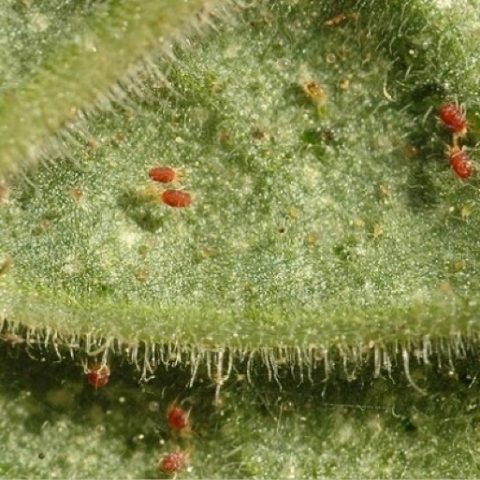
Spider mite is a pest that is difficult to get rid of even with the help of a potent acaricide
The tick prefers dry air. Its appearance is easier to prevent than to harass the pest later. For prevention, you need to monitor the humidity in the apartment.Often indoor flowers are sprayed from a spray bottle. There are inexpensive air humidifiers on sale. They will save the owner from the problems with manual spraying of plants.
Worms are large insects and can be easily killed by hand on many houseplants. But in saxifrage, they often "cluster" at the base of rosette leaves. Removing pests from there by hand means damaging the flower. To get rid of worms, it is recommended to use anti-coccid drugs.
From fungal diseases, indoor saxifrage often suffers from root rot and powdery mildew. Preparations containing copper help well against the latter. Root rot is almost incurable. It is much easier to cut young shoots from the mother bush and root the clones. The adult saxifrage will have to be thrown away.
To prevent root rot, you need to ensure that the soil in the pot is not too wet. And when transplanting, do not bury the root collar in the ground. Also, it is impossible for water to fall into the base of the root outlet during watering. Watering is always carried out under the leaves.
Conclusion
Indoor saxifrage is a very unpretentious flower. Subject to the minimum of care rules, it will delight the owner not only with the inflorescence, but also with the mass of "children" formed at the ends of the stolon-like shoots.






